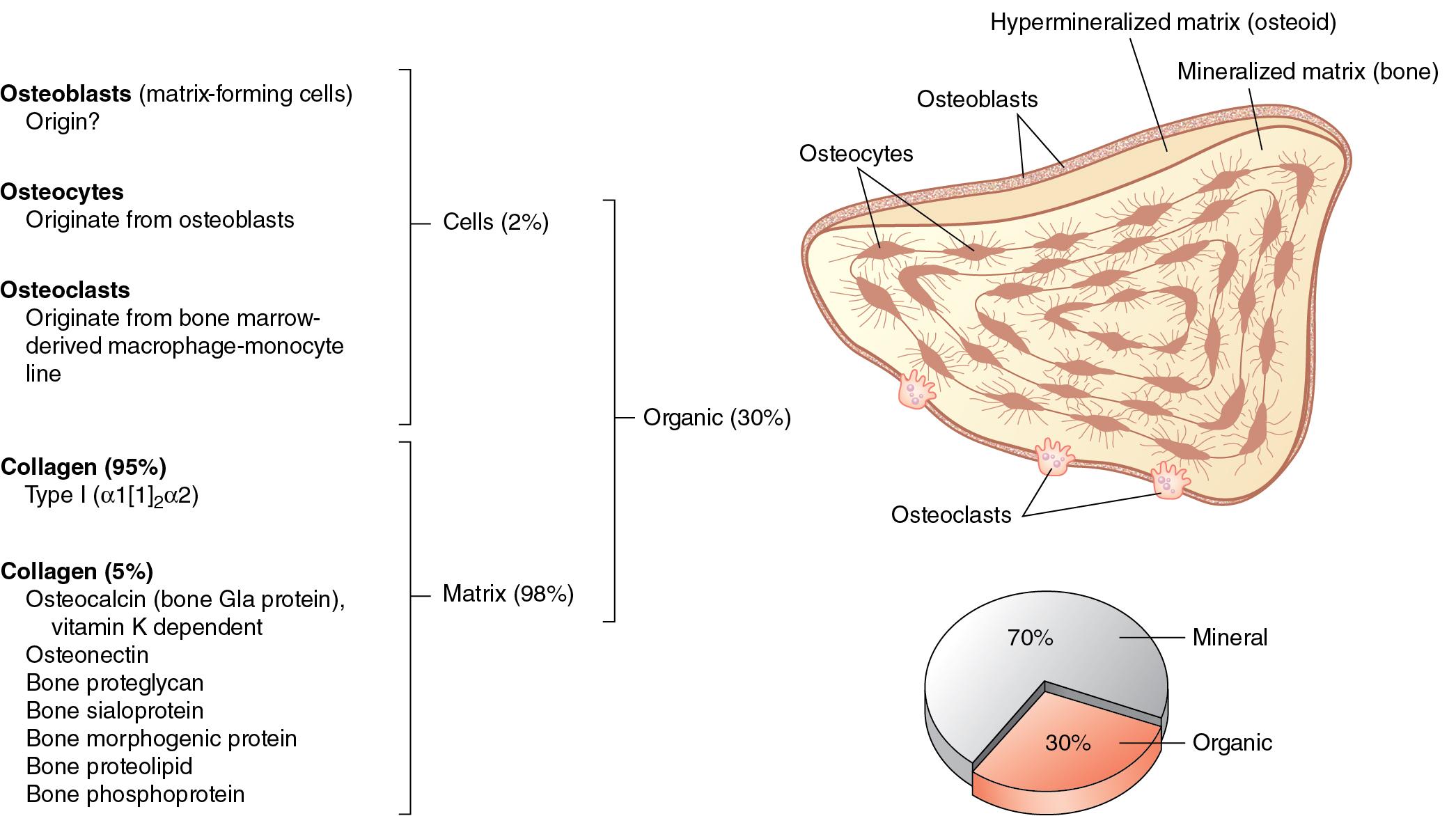Physical Address
304 North Cardinal St.
Dorchester Center, MA 02124
The word skeleton comes from the Greek skellein, meaning to dry up; a dried-up body (skeleton soma) is one with only the bones remaining. Thus etymologically, but also in our cultural imagination, our bones refer to death. However, the skeleton is, like any other organ system, a system dedicated entirely to the functions of life.
The human skeleton is made not only of minerals, but also of blood, proteins, and living cells. The skeletal system’s diverse functions include:
Mineral homeostasis
Hematopoiesis
Mechanical support for movement
Protection
Determination of body size and shape
In this chapter, we will explore how the skeleton as an organ interacts with the body, focusing on:
Anatomy and composition of bones
Bone resorption and deposition
Types of fractures and healing process
Diseases affecting the skeletal system
Like many organs, bone is composed of living cells and an acellular matrix. Bone is dominated by its extracellular matrix, with cells making up just a tiny percentage of the total weight. Like most extracellular matrices, the acellular matrix of bone contains polysaccharide chains called glycosaminoglycans.
These anionic chains bind water and repel one another, creating a viscous but fluid ground substance.
Bone is also a unique tissue in that its ground substance contains not only protein, but also a heavy proportion of inorganic minerals ( Fig. 33.1 ).

The acellular portion of bone is primarily composed of collagen fibers and calcium phosphate crystals. In some ways, this can be compared with reinforced concrete: the collagen is analogous to the steel rods, and the calcium phosphate crystals are compared with the cement.
The calcium phosphate crystals found on and within the collagen fibers are called hydroxyapatite.
The chemical formula for hydroxyapatite is Ca 10 (PO 4 ) 6 (OH) 2 .
These crystals are oriented preferentially along the long axis of the collagen fibers.
The collagen fibers in the bone matrix are composed of subunits called tropocollagen.
Each tropocollagen is a triple-helical supercoil of three polypeptide chains.
The tropocollagens are cross-linked to one another within the collagen fiber at hydroxylysine and lysine residues ( Fig. 33.2 ).
These cross links stabilize the fiber, increase its resistance to deformation, and render it completely insoluble.

About 85% to 90% of the total protein found in bone consists of collagen. Most of the collagen in bone is type 1 collagen. Other types of collagen are infrequent contributors to bone.
Noncollagen proteins (NCP) make up the majority of the remaining bone protein content. These proteins are largely serum-derived and bind to the mineral component of bone. They can be classified into four groups that are somewhat overlapping:
Proteoglycans
Cell attachment proteins
γ-carboxylated proteins
Growth factors
When glycosaminoglycans are rooted to a protein backbone, as is the case in bone matrix, they are called proteoglycans.
Primarily function to fix hydroxyapatite crystal to the collagen fibers.
Poorly defined role in promoting and inhibiting mineralization.
Intact proteoglycans in high concentrations may inhibit calcification.
Partially degraded or sparse proteoglycans may allow calcification to proceed.
Cell attachment proteins anchor osteoblasts and other bone cells to the bone matrix. Four proteins are recognized as having an integral role in cell attachment:
Fibronectin
Thrombospondin
Osteopontin
Bone sialoprotein
The exact physiologic role of the γ-carboxylated proteins is unclear, but measurements of one, called osteocalcin, have proven valuable as markers of bone turnover. Growth factors will be discussed later.
Suspended in the bone matrix, the polypeptide growth factors influence the growth, development, and repair of bone. These factors have various effects on bone and cartilage growth in the fetus and during postnatal life, stimulating the proliferation of osteoblasts and chondroblasts and the proliferation and differentiation of progenitor cells in bone and cartilage cell lines. All of the following factors are produced by osteoblasts and elsewhere in the body and are found in the serum:
Bone morphogenetic proteins (BMP)
Important in early skeletal formation in the embryo.
Platelet-derived growth factor (PDGF)
Promotes chemotaxis in osteoblasts.
Insulin-like growth factor (IGF)
Important in long bone growth.
Fibroblast growth factor (FGF)
May be particularly important in repairing bone injuries.
Transforming growth factor β (TGF-β)
Regulates bone remodeling and enhances osteoblast activity.
Cartilage is another form of extracellular matrix found in the body, composed of proteoglycans and either collagen or elastin.
Covers the ends of bones inside joints, and is found in the trachea, the tip of the nose, and many other areas of the human body.
Serves a precursor to bone in the context of fetal development and bone growth before adulthood.
When cartilage is mineralized (laden with hydroxyapatite) and converted to bone, it has undergone ossification (from the Latin os, meaning bone).
Become a Clinical Tree membership for Full access and enjoy Unlimited articles
If you are a member. Log in here